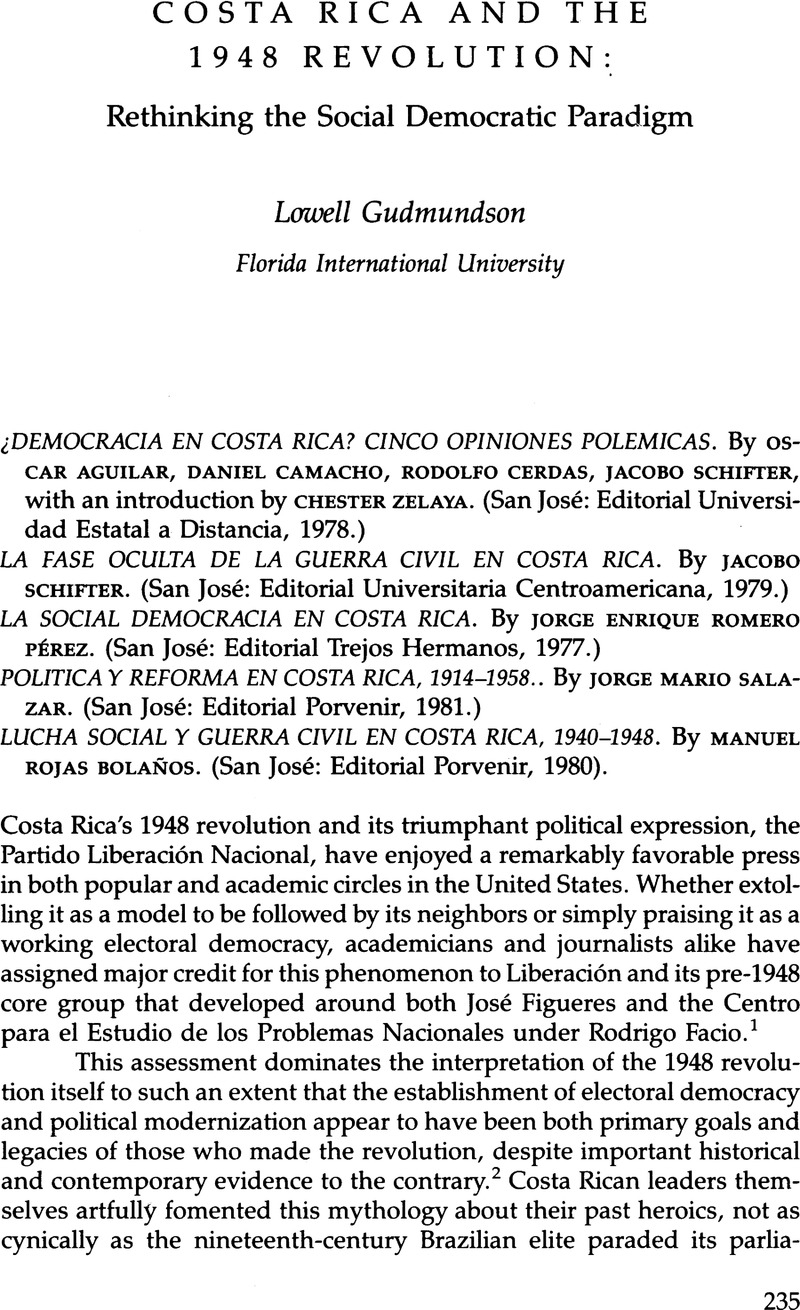Article contents
Costa Rica and the 1948 Revolution: Rethinking the Social Democratic Paradigm
Review products
Published online by Cambridge University Press: 24 October 2022
Abstract

- Type
- Review Essays
- Information
- Copyright
- Copyright © 1984 by Latin American Research Review
References
Notes
1. The classic study of the 1948 revolution is John P. Bell's Crisis in Costa Rica: The 1948 Revolution (Austin: University of Texas Press, 1971). Other major studies that emphasize the middle-class and modernizing elements of the revolutionary program, as well as the triumph of electoral democracy, include: James Busey, Notes on Costa Rican Democracy (Boulder: University of Colorado Press, 1962); Burt H. English, Liberación Nacional in Costa Rica (Gainesville: University of Florida Press, 1971); Harry Kantor, The Costa Rican Election of 1953: A Case Study (Gainesville: University of Florida Press, 1958). An early English-language critique can be found in Susanne Bodenheimer, “The Social-Democratic Ideology in Latin America: The Case of Costa Rica's Partido Liberación Nacional,” Caribbean Studies 10 (1970): 49–96. In addition, Robert Trudeau's doctoral dissertation, “Costa Rican Voting: Its Economic Correlates,” (University of North Carolina at Chapel Hill, 1971) provides important evidence of incongruities with the traditional paradigm. Two recent Costa Rican theses have elaborated upon the ideological content of Liberación party terminology. See Jaime Delgado Rojas, “El pensamiento ideológico-filosófico del Partido Liberación National: análisis de la social democracia costarricense” (Universidad de Costa Rica, 1977); and Rodrigo Quesada Monge, “Los estereotipos político-ideológicos del Partido Liberación Nacional” (Universidad Nacional, Heredia, 1977).
2. Schifter cites declarations on the part of Figueres and his collaborators to the effect that the revolution had not been made simply to “replace one government with another [like it]” nor primarily to insure electoral continuity (pp. 84, 116). These admissions, far from being criticized by the author, help to reveal the larger “transformist” designs of the minority revolutionary group and their unwillingness to accept purely electoral solutions to national problems.
3. Torcuato Di Telia, “Populism and Reform in Latin America,” in Obstacles to Change in Latin America, edited by Claudio Véliz (Oxford: Oxford University Press, 1965), p. 64. The current president of Costa Rica, Luis Alberto Monge, clearly recognizes that Liberación lacks a populist trajectory or support base. For interviews with Monge, see José Luis Vega Carballo, Hacia una interpretación del desarrollo costarricense: ensayo sociológico (San José: Editorial Porvenir, 1980), pp. 211, 221–22.
4. In addition to the work cited above, Vega Carballo has also published a kind of call-to-arms directed at fellow liberacionistas and based on a return to the more radical elements of Facio's nationalistic thought. See “Rodrigo Facio: aspectos de una reflexión sobre el desarrollo nacional,” Debates sobre la teoría de la dependencia y la sociología latinoamericana, edited by Daniel Camancho (San José: Editorial Universitaria Centroamericana, 1979), pp. 739–60. This call for a return to poli-class reformist movements sidesteps the question of whether the party itself is any longer willing to tolerate such struggles, much less lead them.
5. Philippe C. Schmitter, “Paths to Political Development in Latin America,” Changing Latin America: New Interpretations of Its Politics and Society, edited by Douglas Chalmers (New York: The Academy of Political Science, 1972). This framework is developed at greater length in Schifter's La fase oculta, which is a revised edition of his master's thesis at the University of Chicago.
6. Here Schifter uses Trudeau's data to show the lack of Liberación support among working-class and urban lower-class groups in general.
7. In essence, Cerdas repeats Bodenheimer's judgement that social democratic parties and ideologies in Latin America have been bourgeois or middle-class reformist movements and paradigms that had neither predominantly working-class structural support nor notable internal ideological coherence. Thus, Romero's claim that the ideological heritage of Liberación was not social-democratic but neoliberal would come as no surprise to these authors, nor would it prevent them from continuing to refer to such movements as social-democratic in the Latin American context.
8. For a recent attempt to refine this hypothesis in the case of a major new state enterprise or bureaucracy, see Mylena Vega, El Estado costarricense de 1974 a 1978: CODESA y la fracción industrial (San José: Editorial Hoy, 1982), 184 pp.
- 1
- Cited by




